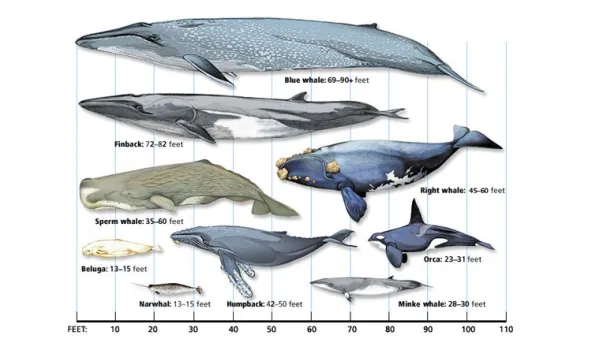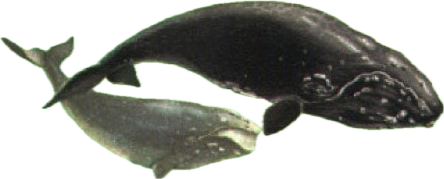Contents
CHAPTER 32. Cetology. (sec. 1) Footnotes
5:29:43

CHAPTER 32. Cetology. (sec. 1)
Already we are boldly launched upon the deep; but soon we shall be lost in its unshored, harbourless immensities. Ere that come to pass; ere the Pequod’s weedy1 hull rolls side by side with the barnacled hulls of the leviathan; at the outset it is but well to attend to a matter almost indispensable to a thorough appreciative understanding of the more special leviathanic revelations and allusions of all sorts which are to follow.
It is some systematized exhibition of the whale in his broad genera,2 that I would now fain put before you. Yet is it no easy task. The classification of the constituents of a chaos, nothing less is here essayed.3 Listen to what the best and latest authorities have laid down.
“No branch of Zoology is so much involved as that which is entitled Cetology,” says Captain Scoresby,4 A.D. 1820.
“It is not my intention, were it in my power, to enter into the inquiry as to the true method of dividing the cetacea into groups and families. * * * Utter confusion exists among the historians of this animal” (sperm whale), says Surgeon Beale, A.D. 1839.
“Unfitness to pursue our research in the unfathomable waters.” “Impenetrable veil covering our knowledge of the cetacea.” “A field strewn with thorns.” “All these incomplete indications but serve to torture us naturalists.”
Thus speak of the whale, the great Cuvier, and John Hunter, and Lesson,5 those lights of zoology and anatomy. Nevertheless, though of real knowledge there be little, yet of books there are a plenty; and so in some small degree, with cetology, or the science of whales. Many are the men, small and great, old and new, landsmen and seamen, who have at large or in little, written of the whale. Run over a few:—The Authors of the Bible; Aristotle; Pliny;6 Aldrovandi; Sir Thomas Browne; Gesner;7 Ray; Linnæus; Rondeletius;8 Willoughby;9 Green;10 Artedi; Sibbald; Brisson;11 Marten; Lacépède; Bonneterre; Desmarest;12 Baron Cuvier; Frederick Cuvier; John Hunter; Owen;13 Scoresby; Beale; Bennett; J. Ross Browne; the Author of Miriam Coffin; Olmstead; and the Rev. T. Cheever.14 But to what ultimate generalizing purpose all these have written, the above cited extracts will show.15
Of the names in this list of whale authors, only those following Owen ever saw living whales; and but one of them was a real professional harpooneer and whaleman. I mean Captain Scoresby. On the separate subject of the Greenland or right-whale,
 he is the best existing authority. But Scoresby knew nothing and says nothing of the great sperm whale,
he is the best existing authority. But Scoresby knew nothing and says nothing of the great sperm whale,

compared with which the Greenland whale is almost unworthy mentioning. And here be it said, that the Greenland whale is an usurper upon the throne of the seas.16 He is not even by any means the largest of the whales. Yet, owing to the long priority of his claims, and the profound ignorance which, till some seventy years back,17 invested the then fabulous or utterly unknown sperm-whale, and which ignorance to this present day still reigns in all but some few scientific retreats and whale-ports; this usurpation has been every way complete. Reference to nearly all the leviathanic allusions in the great poets of past days, will satisfy you that the Greenland whale, without one rival, was to them the monarch of the seas. But the time has at last come for a new proclamation. This is Charing Cross;18 hear ye! good people all,—the Greenland whale is deposed,—the great sperm whale now reigneth!
There are only two books in being which at all pretend to put the living sperm whale before you, and at the same time, in the remotest degree succeed in the attempt. Those books are Beale’s and Bennett’s; both in their time surgeons to English South-Sea whale-ships, and both exact and reliable men. The original matter touching the sperm whale to be found in their volumes is necessarily small; but so far as it goes, it is of excellent quality, though mostly confined to scientific description. As yet, however, the sperm whale, scientific or poetic, lives not complete in any literature. Far above all other hunted whales, his is an unwritten life.
Now the various species of whales need some sort of popular comprehensive classification, if only an easy outline one for the present, hereafter to be filled in all its departments by subsequent laborers. As no better man advances to take this matter in hand, I hereupon offer my own poor endeavors. I promise nothing complete; because any human thing supposed to be complete, must for that very reason infallibly be faulty. I shall not pretend to a minute anatomical description of the various species, or—in this place at least—to much of any description. My object here is simply to project the draught19 of a systematization of cetology. I am the architect, not the builder.
But it is a ponderous task; no ordinary letter-sorter in the Post-Office is equal to it. To grope down into the bottom of the sea after them; to have one’s hands among the unspeakable foundations, ribs, and very pelvis of the world; this is a fearful thing. What am I that I should essay to hook the nose of this leviathan! The awful tauntings in Job20 might well appal me. Will he (the leviathan) make a covenant with thee? Behold the hope of him is vain! But I have swam through libraries and sailed through oceans; I have had to do with whales with these visible hands; I am in earnest; and I will try. There are some preliminaries to settle.
First: The uncertain, unsettled condition of this science of Cetology is in the very vestibule21 attested by the fact, that in some quarters it still remains a moot point whether a whale be a fish. In his System of Nature, A.D. 1776, Linnæus declares, “I hereby separate the whales from the fish.” But of my own knowledge, I know that down to the year 1850, sharks and shad, alewives22 and herring, against Linnæus’s express edict, were still found dividing the possession of the same seas with the Leviathan.
The grounds upon which Linnæus would fain have banished the whales from the waters, he states as follows: “On account of their warm bilocular heart,23 their lungs, their movable eyelids, their hollow ears, penem intrantem feminam mammis lactantem,24” and finally, “ex lege naturæ jure meritoque.”25 I submitted all this to my friends Simeon Macey and Charley Coffin, of Nantucket, both messmates of mine in a certain voyage, and they united in the opinion that the reasons set forth were altogether insufficient. Charley profanely hinted they were humbug.
Be it known that, waiving all argument, I take the good old fashioned ground that the whale is a fish, and call upon holy Jonah to back me. This fundamental thing settled, the next point is, in what internal respect does the whale differ from other fish. Above, Linnæus has given you those items. But in brief, they are these: lungs and warm blood; whereas, all other fish are lungless and cold blooded.
Next: how shall we define the whale, by his obvious externals, so as conspicuously to label him for all time to come? To be short, then, a whale is a spouting fish with a horizontal tail. There you have him. However contracted, that definition is the result of expanded meditation. A walrus spouts much like a whale, but the walrus is not a fish, because he is amphibious. But the last term of the definition is still more cogent, as coupled with the first. Almost any one must have noticed that all the fish familiar to landsmen have not a flat, but a vertical, or up-and-down tail. Whereas, among spouting fish the tail, though it may be similarly shaped, invariably assumes a horizontal position.
By the above definition of what a whale is, I do by no means exclude from the leviathanic brotherhood any sea creature hitherto identified with the whale by the best informed Nantucketers; nor, on the other hand, link with it any fish hitherto authoritatively regarded as alien.26 Hence, all the smaller, spouting, and horizontal tailed fish must be included in this ground-plan of Cetology. Now, then, come the grand divisions of the entire whale host.27
==Have notes to add? Email me heather@craftlit.com or call 1-206-350-1642 or use speakpipe.com/craftlit.==
Footnotes
Footnotes
-
weedy = thin ↩
-
genera = how organisms with characteristics in common can be grouped. ↩
-
essayed = attempted ↩
-
William Scoresby was an Arctic explorer who wrote Account of the Arctic Regions with a History and Description of the Northern Whale Fishery. Thomas Beale wrote The Natural History of the Sperm Whale. (BTW, Phillip Pullman named his character Lee Scoresby after * the actor Lee Van Cleef*—whose looks Pullman used as the model for the character’s—and William Scoresby.)
 ↩
↩ -
Georges Cuvier was a major figure in many of the natural sciences in the early 19th century. John Hunter was a Scottish scientist, primarily a surgeon, of the late 18th century, mentioned for his studies in anatomy. René-Primavère Lesson was a naturalist (primarily an ornithologist and herpetologist) of the early 19th century. ↩
-
This list is Melville sharing ALL the whale-freindly artists and writers he knows of: the Authors of the Bible wrote the Book of Jonah; Aristotle was the first to recognize that whales were not fish, in his Historia Animalium; Pliny the Elder (who died in 79 during the eruption of Vesuvius) described orcas hunting whale calves near the Straits of Gibraltar. ↩
-
More Whale-friendly folks: Aldrovandi was an artist/illustrator who drew whales (not always entirely accurately) in the 17th century; Sir Thomas Browne wrote Pseudodoxia Epidemica, Book of Vulgar Errors (1646); Gesner is Conrad Gesner, who drew and wrote about whales and sea monsters in “Animaux aquatiques et monstres des mers septentrionales” (1560). (There is also Abraham Gesner, who patented kerosene in 1854, just a few years after Moby-Dick was published, and which was far cheaper than whale oil as a lighting fuel.) ↩
-
John Ray published several works on cetaceans in the 17th century and eventually concluded that they were not fish. He aslo coined the term “species”; Linnaeus developed a classification system for plants and animals and in the 1758 edition of Systema Naturae placed cetaceans in the Mammalia; Rondeletius is Guillaume Rondelet, who wrote Libri de Piscibus Marinis in quibus verae Piscium effigies expressae sunt in 1554 and Universae Aquatilium Historiae pars altera the following year. ↩
-
Willoughby: likely Francis Willughby (1635-1672), English ornithologist and icthyologist. ↩
-
Green: possibly John Green, the compiler of the Astley Collection of adventure narratives, published in 1745 ↩
-
Peter Artedi was an 18th century Swede called the “Father of Ichthyology”, and recognized that cetaceans were distinct from fish, though based on the position of the fins rather than mammalian characteristics; Robert Sibbald wrote about the Blue whale in Phalainologia Nova (1692); it was originally called “Sibbald’s rorqual” and originally had Sibbald’s name in its Latin denotation; Mathurin Jacques Brisson described the humpback whale in Regnum Animale (1756), and his name was originally used for the Latin denotation. ↩
-
Friedrich Martens (not to be confused with the Russian diplomat of the same name) wrote an account of his time as a ship’s surgeon on an Arctic whaling voyage in the late 17th century; Bernard-Germain-Étienne de La Ville-sur-Illon, Comte de Lacépède was a French naturalist who contributed to the Comte de Buffon’s great work on natural history in the late 18th century; Abbé Pierre Joseph Bonneterre contributed several sections on whales to the Tableau encyclopédique et méthodique. in the 1780s and 1790s; Anselme Gaëtan Desmarest was a French zoologist of the early 19th century. ↩
-
When Melville refers to “the great Cuvier” earlier, he means Georges Cuvier, while here he lists both him and Frédéric Cuvier, Georges’s younger brother, a well-known zoologist in his own right; John Hunter published Observations on the structure and oeconomy of whales (1787); Sir Richard Owen founded the British Natural History Museum, and it was specifically intended and designed to be able to display whales, being the largest living animals. ↩
-
Scoresby and Beale were also mentioned earlier Footnote 15; Frederick Debell Bennett wrote A Whaling Voyage round the Globe, from the Year 1833 to 1836; J. Ross Browne wrote Etchings of a Whaling Cruise (1846); Joseph C. Hart was “the Author of Miriam Coffin” (Miriam Coffin -or- The Whale-Fishermen: A Nantucket Novel (1834), a novel based on a real person); Francis Allyn Olmstead wrote Incidents of a Whaling Voyage (1841); The Rev. T. Cheever is Henry T. Cheever, who wrote The Whale and His Captors (1850). ↩
-
(Melville’s most-likely source: The Penny Cyclopædia, a 25 page article titled “Whales”. Sources for these footnotes: When Whales Became Mammals: The Scientific Journey of Cetaceans From Fish to Mammals in the History of Science by Aldemaro Romero, and Steven Olsen-Smith’s Melville’s copy of Thomas Beales “The Natural History of the Sperm Whale and the Composition of Moby Dick”](https://nrs.harvard.edu/URN-3:HUL.INSTREPOS:37363364). ↩
-
HA! Soapbox, meet Melville. ↩
-
70-years-back = 1780s when New England whalers first went to the Pacific for Sperm Whales. ↩
-
Charing Cross=“center” of old London, site where crowds used to watch public executions, including King Charles I in 1649. The statue of King Charles I is at the junction of The Strand, Whitehall, and Cockspur Street, just south of Trafalgar Square, serves as this reference point. This practice has been in place since the early 19th century. ↩
-
a rough draft ↩
-
Book of Job 41.4,9 - the “awe-full” demands God makes of Job by reminding him of the power of the Leviathan as a way of describing His own power. ↩
-
vestibule: usually an antechamber - the room before the real room. Here’s he’s using it to indicate we’re at the very beginning of the information. ↩
-
North Atlantic fish, in the Herring family. ↩
-
bilocular = two-chambered. ↩
-
Penem intrantem feminam mammis lactantem: Latin for “the penis enters the female, which gives milk from teats” ↩
-
ex lege naturæ jure meritoque = Latin for “from the law of nature, justly and deservedly”. ↩
-
MELVILLE’S FOOTNOTE: I am aware that down to the present time, the fish styled Lamatins and Dugongs (Pig-fish and Sow-fish of the Coffins of Nantucket) are included by many naturalists among the whales. But as these pig-fish are a noisy, contemptible set, mostly lurking in the mouths of rivers, and feeding on wet hay, and especially as they do not spout, I deny their credentials as whales; and have presented them with their passports to quit the Kingdom of Cetology. ↩
-
host = army ↩